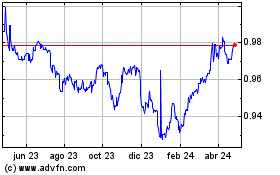Euro Advances; U.S. Dollar Falls As European Stocks Climb
23 Febrero 2022 - 2:05AM
RTTF2
The euro climbed against its major counterparts in the European
session on Wednesday, while the U.S. dollar weakened, as sanctions
imposed on Russia by the U.S. and its allies were softer, helping
lift sentiment.
Markets breathed a sigh of relief after the U.S. held back from
introducing aggressive sanctions against Russia.
Russian President Vladimir Putin said that he is willing to have
diplomatic talks over the Ukraine conflict, but the country's
interests are "non-negotiable."
Putin's comments came after the imposition of sanctions on
Russia following the recognition of two Ukrainian separatist
regions as sovereign states.
U.N. chief Antonio Guterres dismissed Russia's assertion that
troops sent to eastern Ukraine will uphold peace.
Final data from Eurostat showed that Eurozone inflation rose to
a record high in January, as initially estimated, driven by surging
energy prices.
Inflation rose to a record 5.1 percent in January from 5.0
percent in December. The rate matched the flash estimate published
on February 2.
The euro advanced to 130.71 against the yen and 1.1359 against
the greenback, off its early lows of 130.14 and 1.1316,
respectively. The euro may find resistance around 132.00 against
the yen and 1.16 against the greenback.
The euro edged up to 1.0460 against the franc and 0.8354 against
the pound, following its prior lows of 1.0420 and 0.8325,
respectively. The euro is likely to face resistance around 1.06
against the franc and 0.86 against the pound.
In contrast, the euro weakened to nearly 5-week lows of 1.5610
against the aussie and 1.6684 against the kiwi, after gaining to
1.5698 and 1.6828, respectively in early trades. The next possible
support for the currency is seen around 1.53 against the aussie and
1.64 against the kiwi.
The euro reversed from a previous high of 1.4469 against the
loonie, dropping to 1.4410. On the downside, 1.42 is likely seen as
the next support for the euro.
Pulling away from its early highs of 1.2770 against the loonie,
0.7216 against the aussie and 0.6729 against the kiwi, the
greenback depreciated to a 5-day low of 1.2703 and nearly 5-week
lows of 0.7267 and 0.6799, respectively. The greenback is seen
finding support around 1.26 against the loonie, 0.75 against the
aussie and 0.70 against the kiwi.
The greenback touched a 2-day low of 1.3620 against the pound,
down from a high of 1.3574 seen at 5:00 pm ET. Should the greenback
falls further, 1.38 is likely seen as its next possible support
level.
After climbing to 0.9219 at 4 am ET, the greenback dropped to
0.9183 against the franc. The greenback may test support around the
0.90 region.
The greenback retreated to 115.02 against the yen, from a high
of 115.17 hit at 4 am ET. If the greenback slides further, 112.00
is likely seen as its next support level.
Euro vs CHF (FX:EURCHF)
Gráfica de Divisa
De Mar 2024 a Abr 2024

Euro vs CHF (FX:EURCHF)
Gráfica de Divisa
De Abr 2023 a Abr 2024
